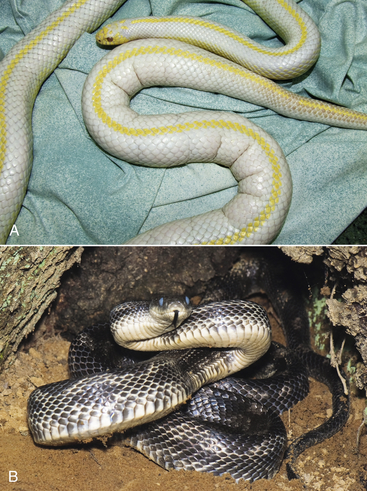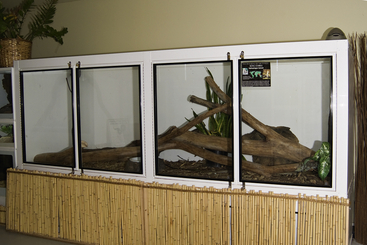Chapter 1
Current Herpetologic Husbandry and Products
Enclosure Type
Besides enclosures for snakes and lizards, plastic and fiberglass tubs suitable for keeping aquatic and semiaquatic turtles are available. A number of manufacturers produce plain, round or rectangular tubs in sizes from 0.5 gallons to 5000 gallons (1.9 to 18,927 L) (Figure 1-1). Waterland Tubs (www.waterlandtubs.com) is a line of plastic tubs designed specifically for keeping aquatic and semiaquatic turtles. These tubs have a water side and an access ramp to a land side to allow for basking and egg laying. They come in multiple sizes up to 200 gallons (757 L). Waterland tubs are lightweight, can be placed outside, and can be modified to add bulk heads and drains to make cleaning easier.
Water Filtration
 Mechanical filtration—this includes pumps, canisters, and air lifts. Mechanical filtration is the physical action of moving water over media (e.g., protein skimmer foam or filter media). Mechanical filtration removes the large particulate matter in the water and also oxygenates the water.
Mechanical filtration—this includes pumps, canisters, and air lifts. Mechanical filtration is the physical action of moving water over media (e.g., protein skimmer foam or filter media). Mechanical filtration removes the large particulate matter in the water and also oxygenates the water.
 Biologic filtration—within a high surface area filter, on the gravel, and walls of the aquarium, live bacteria that are responsible for breaking down ammonia (produced by the reptile or amphibian) into nitrite and then nitrate, the least toxic form of nitrogenous waste. This process is called the nitrification cycle and takes about 21 days in most aquariums to become established in a new setup. Aquatic reptiles are not as sensitive to this cycle as fish and amphibians, which are exquisitely sensitive to ammonia and its by-products.
Biologic filtration—within a high surface area filter, on the gravel, and walls of the aquarium, live bacteria that are responsible for breaking down ammonia (produced by the reptile or amphibian) into nitrite and then nitrate, the least toxic form of nitrogenous waste. This process is called the nitrification cycle and takes about 21 days in most aquariums to become established in a new setup. Aquatic reptiles are not as sensitive to this cycle as fish and amphibians, which are exquisitely sensitive to ammonia and its by-products.
 Chemical filtration—activated carbon has great absorbency and is used to remove harmful chemicals and color compounds from water. Other examples are sodium hydroxymethylsulfinate and sodium thiosulfate, which remove ammonia and chlorine, respectively.
Chemical filtration—activated carbon has great absorbency and is used to remove harmful chemicals and color compounds from water. Other examples are sodium hydroxymethylsulfinate and sodium thiosulfate, which remove ammonia and chlorine, respectively.
Zoo Med Laboratories (3650 Sacramento Dr., San Luis Obispo, CA 93401, http://zoomed.com) has a complete line of terrariums, aquatic habitats, and filtrations for all species of reptiles. Exo Terra (Rolf C. Hagen [USA] Corp, Mansfield, MA 02048, http://www.exo-terra.com) has many filters and accessories for amphibian and aquatic reptile enclosures.
Space Requirements
The once-popular practice, especially among snake and gecko keepers, of keeping dozens to hundreds of specimens in small, Spartan, laboratory-style cages with minimal space and few cage furnishings is falling out of favor. Minimalist cage design facilitates ease of maintenance for the keeper but provides little for the welfare or behavioral well-being of the animals. An important trend in herpetoculture is to downsize collections and provide spacious cages for the remaining specimens. Indeed, for observation and appreciation of a reptile’s natural behavior, a more natural enclosure must be provided. An adult Cornsnake (Pantherophis [Elaphe] guttatus) or Kingsnake (Lampropeltis getula) might survive in a 20-gallon (76 L) aquarium but would thrive in a cage measuring 4 × 2 × 2 feet high (1.2 × 0.6 × 0.6 m high). Snakes and other reptiles in larger cages tend to be more active and have better muscle tone (Figure 1-2). Larger cages allow more cage furniture such as climbing branches, multiple hides, and larger water sources. They allow for wider thermal and humidity gradients and better thermoregulation. Larger cages allow for the use of ventilation fans and misters. Larger cages usually are more aesthetically appealing (Figure 1-3).

FIGURE 1-2 A, “Cage potato” Kingsnake (Lampropeltis getula) exhibiting poor muscle tone and obesity due to lack of exercise and overfeeding. B, A wild Midland Rat Snake (Pantherophis [Elaphe] spiloides) showing well-developed musculature as a result of a large home range and more frequent climbing and foraging than most captive snakes undertake. (Photos courtesy Dr. Stephen L. Barten, Vernon Hills Animal Hospital, Mundelein, Ill.)

FIGURE 1-3 This plastic cage by Habitat Systems Ltd. (Des Moines, Iowa) located in a nature center measures 12 feet wide by 3 feet deep and 4 feet high (3.7 × 0.9 × 1.2 m) and houses a King Cobra (Ophiophagus hannah), a large, very active species. Large reptile enclosures have many advantages and are preferred over small, minimalist setups. (Photo courtesy Dr. Stephen L. Barten, Vernon Hills Animal Hospital, Mundelein, Ill.)
Some guidelines for cage size have been published.1,2 One formula recommends that the length plus the width of a snake cage should at a minimum equal the length of the snake; thus a 4 × 2-foot (1.2 × 0.6 m) cage is the minimum size recommended for a 6-foot (1.8 m) long snake. Likewise large lizards should be housed in cages that are twice as long as the total length of the lizard; thus a 4-foot (1.2 m) wide cage is acceptable for a 2-foot (0.6 m) lizard (the minimum cage size should be 1.5 times as long as the length of the lizard).3 The upper range of cage size is limited only by the spatial and financial restrictions of the owner. It is incorrect to assume that reptiles, being ectothermic, are sedentary and inactive. In fact, with adequate available space, most reptiles are highly active with complex behaviors.4
A number of companies produce plastic or fiberglass enclosures in standard or custom designs for keeping reptiles and amphibians. Most of these companies have Web sites, and some offer free shipping. A variety of these products may be viewed at many of the large reptile shows held periodically around the country. A partial list of such companies in no particular order are included in Box 1-1.
Substrate
Natural substrates can be mixed and matched to meet the needs of various species. Commonly used materials that can be blended together in various combinations to meet the needs of the reptile or amphibian include beach sand, peat, top soil (with no insecticide or fertilizer), Eco Earth (compressed, expandable coconut fiber bedding; Zoo Med Laboratories Inc, San Luis Obispo, Calif, http://www.zoomed.com), and leaf mulch. For instance, a desert species might be kept on a mix with more sand and less soil, peat, and leaf mulch, while a forest species requiring more moisture might be kept on a mix with more leaf mulch, soil, and peat and less sand, if any. A topping of dead leaves adds aesthetic appeal, and the leaves decompose and add to the soil mix.
Natural Backgrounds
Various companies manufacture natural-looking backgrounds and cage furniture that make a cage more aesthetically appealing, provide more climbing and enrichment for the inhabitants, are sturdy, and yet are easy to clean and disinfect (Figure 1-4). The use of such backgrounds can make an ordinary enclosure a true showpiece and allow for visualization of natural reptile behaviors (Figure 1-5). These backgrounds should be adequately secured, and care must be taken to block any access to the space behind the background. If a snake or lizard were to disappear into that space it may be necessary to tear down the entire enclosure to access the reptile. Any holes through the background for tubing or ventilation can be secured by affixing screen mesh over the hole using silicone adhesive applied to the rear of the background around the hole. Another potential hazard is improperly secured backgrounds or cage furniture made of heavy material that can fall and result in crushing injuries to enclosure inhabitants. A partial list of companies that provide these products in no particular order are included in Box 1-2.




